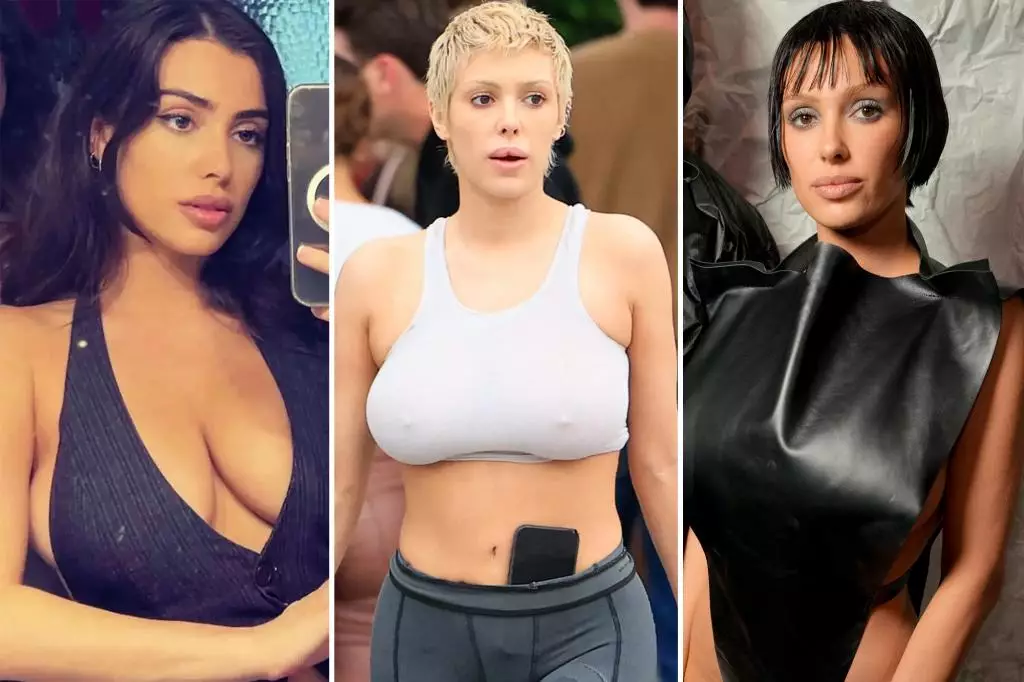Bianca Censori’s transformation over the past year has not only captivated the eyes of fashion enthusiasts but has also stirred conversations about identity, autonomy, and the impact of high-profile relationships on personal style. Since her marriage to Kanye West in December 2022, Censori has undergone a significant style overhaul that challenges and redefines notions of femininity and self-presentation, particularly within the context of her relationship with the controversial rapper.
The whirlwind nature of Censori and West’s union—taking place less than a month after West’s high-profile divorce from Kim Kardashian—has undoubtedly set the stage for her dramatic style transformation. Initially perceived as a non-legal partnership, their marriage has proven to be a turning point in her life; Censori, formerly a Yeezy employee, has evolved into a central figure in West’s ever-controversial narrative. The abrupt change in her appearance—from dark, flowing hair to a striking platinum pixie cut—illustrates not just a shift in aesthetic but a rebranding that aligns her more closely with the Yeezy ethos.
Censori’s pre-West style bore a resemblance to Kardashian’s, characterized by sultry outfits, heavy contour makeup, and long hair. Such parallels are interesting, as they illustrate how women in the public eye are often compared to one another, particularly when linked to the same influential male figure. However, upon marrying West, Censori’s wardrobe started reflecting the minimalist and monochromatic styles that have become synonymous with Yeezy: blacks, grays, and creams dominating her outfits, emphasizing a uniformity that contrasts sharply with her former vibrant looks.
Bianca’s shift in fashion choices raises questions about the concept of influence and agency. While many may view her new style as simply following her husband’s lead, it transcends mere imitation; it highlights the multifaceted nature of identity development in a relationship. Censori’s embrace of sheer tights, transparent bra tops, and second-skin bodysuits are not just fashion choices; they symbolize a merger of her personal identity with the high-stakes world that West embodies.
Her bold sartorial statements—including bodysuits crafted from multiple pairs of sheer tights—force us to reconsider the lines between fashion, art, and personal expression. With each bold choice, Censori challenges the conventions of traditional femininity and norms about modesty, seeking empowerment through her skin-baring attire. Notably, her experimentation with clothing that blurs the line between fashion and utility—such as wearing stockings as a full outfit—suggests a desire for freedom and self-expression that contradicts traditional expectations of a celebrity wife.
Censori’s transition into a lifestyle characterized by monochromatic hues and body-conscious styles has raised the profile of minimalist fashion. By opting for outfits that often forego traditional footwear, or completely relying on bare feet wrapped in bandages, she offers a new lens on chicness that aligns more with high fashion runway trends than everyday practicality. Such decisions portray a bold confidence and willingness to redefine norms, albeit within the framework of a very public marriage.
Additionally, her choice to often don face coverings and masks—much like her husband—further underscores the idea of personal branding in the contemporary fashion landscape. Masks have long played a role in fashion, from runway to streetwear, but their incorporation into Censori’s personal style speaks to broader societal conversations about privacy, protection, and individuality in an age where personalities are often overwhelmed by public perceptions.
The evolution of Bianca Censori from employee to fashion icon signifies much more than aesthetic changes; it represents a profound change in how identity can be forged or reshaped through significant relationships. As she navigates her own sense of self amidst the glamour and scrutiny that comes with being Kanye West’s wife, Censori’s journey highlights the complexities of femininity, celebrity culture, and personal expression. Whether perceived positively or negatively, her transformation is a relevant study of how fashion serves not just as clothing but as a powerful tool for self-identification, particularly for women in the spotlight.

